
The Emma Willard House is a historic house at 131 South Main Street in Middlebury, Vermont, United States. Built in 1809, it was from 1809 to 1819 the home of Emma Willard (1787–1870), an influential pioneer in the development of women's education in the United States. Willard established a school for girls at her home in 1814 known as the Middlebury Female Seminary. The school was a precursor to the Emma Willard School, an all girl, private boarding and university preparatory day school opened by Willard in 1821 in Troy, New York. The house was declared a National Historic Landmark in 1965. It now houses the Middlebury College Admissions Office.
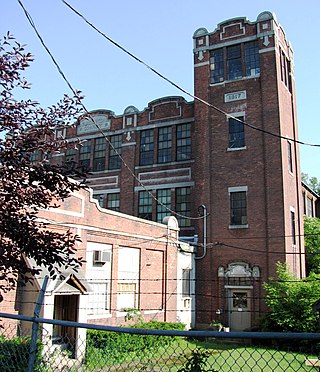
The Blackinton Historic District is a historic district in the western part of North Adams, Massachusetts, roughly along Massachusetts Avenue between Ashton and Doanes Avenues and Church Hill and the Boston & Maine Railroad. The district, which encompasses North Adams' best preserved mill village, was added to the National Register of Historic Places in 1985.

The Boardman is a series of rowhouses at 39-53 Montana Street, occupying an entire city block between Hoosac and Blackinton Streets in North Adams, Massachusetts. The building was, at the time of its construction (1899–1901), one of the most elaborate multiunit buildings in the city, and were added to the National Register of Historic Places in 1985.

Citizens Hall is a historic municipal building at 13 Willard Hill Road in Interlaken, a village of Stockbridge, Massachusetts. Built in 1870 as a schoolhouse and community meeting center, it is a well-preserved local example of Second Empire architecture. The hall was listed on the National Register of Historic Places in 1972, and included as a contributing property in the Old Curtisville Historic District in 1976. It now houses Berkshire Art Center.

The Johnson Manufacturing Company was a historic mill complex at 65 Brown Street in North Adams, Massachusetts. Developed beginning in 1872 and enlarged through the early 20th century, it was at the time of its 1985 listing on the National Register of Historic Places a well-preserved example of late 19th century industrial architecture, used for the production of textiles for many years. The complex was demolished in 2007.

The Monument Square–Eagle Street Historic District is a historic district encompassing the civic heart of North Adams, Massachusetts. When it was originally designated in 1972, the district encompassed Monument Square – west of the intersection of Main Street and Church Street, and the location of a Civil War memorial – and the area around it. This designation included the North Adams Public Library, the First Baptist Church and First Congregational Church, and a block of shops Eagle Street. In 1988, the district's boundaries were increased to be roughly bounded by Holden, Center and Union Streets, the East Middle School, Summer Street, and Main Street. This expansion extended the district westward along Summer Street to include the US Post Office building and St. John's Church, and eastward to include Colgrove Park, the middle school, and St. Francis Catholic Church. An additional block of commercial buildings was also added on the north side of West Main Street, extending just west of Holden Street.

The Norad Mill is a historic mill located in Braytonville, North Adams, Massachusetts. It is the oldest mill complex in North Adams that has not had its exterior significantly altered, making visible much of its Italianate styling.

Phillips Woolen Mill is a historic mill at 71 Grove Street in Adams, Massachusetts. With a construction history dating to the mid-19th century, it is a good example of small textile mill complex of that period, containing elements that date from the 1920s potentially back as far as the 1830s. The mill complex was added to the National Historic Register in 1982.
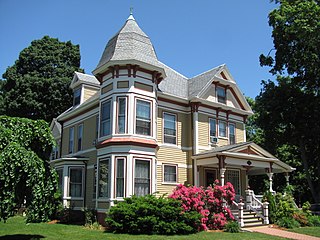
The Woburn Street Historic District of Reading, Massachusetts encompasses a two-block section of late 19th century upper-class housing. The 10-acre (4.0 ha) extends along Woburn Street from Summer Street to Temple Street, and includes sixteen houses on well-proportioned lots along an attractive tree-lined section of the street. The historic district was listed on the National Register of Historic Places in 1985.

The Eaton–Prescott House is a historic house at 284 Summer Avenue in Reading, Massachusetts. Its oldest portion was probably built before 1757. By that year it had acquired a leanto section, since removed or incorporated into the main structure of the house. It is now a principally Georgian style house, although its door surround dates to the Greek Revival period of the 1830s-1840s. The house stands on land that was in the Eaton family as far back as the late 17th century.

The Willard Richmond Apartment Block is an historic apartment house at 43 Austin Street in Worcester, Massachusetts. Built sometime between 1879 and 1886, it is one of the first apartment blocks built in the Main-Wellington-Chandler area, which had one of the city's highest concentrations of such buildings by 1900. The building was listed on the National Register of Historic Places in 1985.
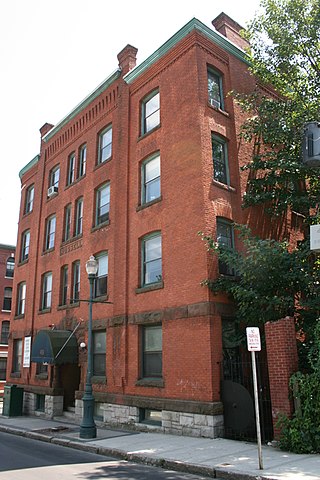
The Russell is an historic apartment house in Worcester, Massachusetts. Built in 1894, it is one of the few surviving apartment blocks, of many built, in the Main-Wellington-Chandler area, which had one of the city's highest concentrations of such buildings by 1900. The building was listed on the National Register of Historic Places in 1985.
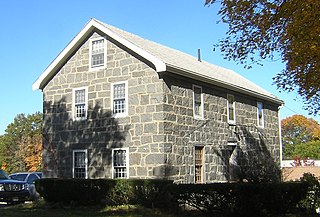
The House at 92 Willard Street in Quincy, Massachusetts, is, somewhat oddly, believed to be the only granite house ever built in the city, which is well known for its granite quarries. The house is located in West Quincy, near its famous granite quarries, and was built in the 1830s. It is a 2+1⁄2-story structure, fashioned out of granite blocks, with a gable roof. A single-story hip-roofed porch once wrapped around two sides; it was an early 20th-century addition that has since been removed. The main facade is three bays wide, with the entrance at the center.

Marcus Fayette Cummings was an American architect active in the Capital District region of the U.S. state of New York. Born in Utica, he later established his practice in the city of Troy, where many of his buildings are located in the Central Troy Historic District and listed on the National Register of Historic Places. Firm listed as Cummings & Brit in the Gazetteer and Business Directory of Rensselaer County, N. Y., for 1870–71. In 1891 he made his son, Frederick, a partner in the office, and promptly retired to Vineyard Haven, Massachusetts, on Martha's Vineyard. He maintained only a financial interest in the office of M. F. Cummings & Son, which would last into the 1930s.

The Willard Homestead is a historic house on Sunset Hill Road in Harrisville, New Hampshire. Built about 1787 and enlarged several times, it is notable as representing both the town's early settlement history, and its summer resort period of the early 20th century. The house was listed on the National Register of Historic Places in 1988.
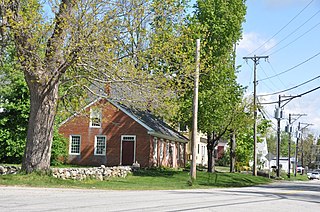
The New Ipswich Center Village Historic District encompasses the historic center of the rural town of New Ipswich, New Hampshire. The center village is the town's most densely populated area, with a history dating to the town's founding in 1735. The district extends along Turnpike Road between King and Porter Roads, and southward in a roughly triangular shape, the southern point of which is at the junction of Main Street and Willard Road. The village includes a large number of residences, which were mainly agricultural at first, but also include a number of properties built as summer resort houses in the late 19th and early 20th centuries. It also includes most of the town's historic civic buildings, including its historic town hall, and the Barrett House, now a museum property owned by Historic New England. The district was listed on the National Register of Historic Places in 1991.

The Charlestown Main Street Historic District encompasses the historic heart of Charlestown, New Hampshire. It is located along Main Street, roughly between Lower Landing Road and Bridge Street, and encapsulates more than two hundred years of the town's history. The district was listed on the National Register of Historic Places in 1987.

The Town Center Historic District encompasses the historic village center of South Hampton, New Hampshire. Centered around the Barnard Green, the town common, on New Hampshire Route 107A, it includes architectural reminders of the town's growth and change over time. The district was listed on the National Register of Historic Places in 1983.
Edwin Thayer Barlow was an architect with Carrère and Hastings in New York City and at his own architectural practice in North Adams, Massachusetts. He designed a couple of buildings listed on the National Register of Historic Places as well as renovating one that is a contributing property to the Blackinton Historic District. He also designed several school buildings.





















